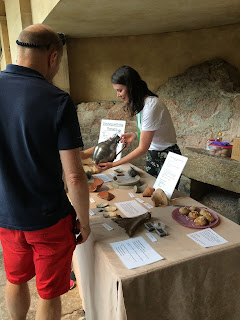Recently, visited Batheaston to display a range of incredible objects from the local area.
Of course, I chose my favourite subject – coins! We had several lovely Roman
coins on display, from Emperor Domitian (77AD) to Emperor Gratian (367AD), but
my two favourite coins found during excavations at the Batheaston Bypass aren’t
Roman at all…
The first is
what I think is one of the most beautiful coins in the collection. It is a
sceat (a small silver coin) from the eighth century AD - just before the Viking
invasion. It might have been minted in Denmark, or Frisia (now part of the
Netherlands or Northern Germany), but there is a lot of ongoing debate about
when and where these coins were made.
On one side, there is the bearded face of the Ancient German sky god called “Wodan”, related to the Norse god Odin. On the other there is a mythical monster, possibly a dragon!
On one side, there is the bearded face of the Ancient German sky god called “Wodan”, related to the Norse god Odin. On the other there is a mythical monster, possibly a dragon!
The second
is a European copy of an English silver penny, originally minted for Edward I
(1288-1299). At the time, these were nicknamed “crockards”, which is a term of
uncertain origin. There is also a medieval Latin word crocardus which is translated as “bad money”, but this may have
been derived from the English term and not the other way round.
At the time,
the English silver penny was famous throughout Europe for its quality and
purity. European merchants would trade their goods to the English for the
coins. Then they would melt down the coins, mix the silver with some cheaper
metal, and mint more coins for themselves. By making the coins look like the
English pennies, they could then pretend that the coins were just as high in
value as the originals.
However, the
crockards weren’t considered “counterfeit”, because they were not identical to
the English pennies. The names of the European moneyers were on the coins, and
instead of the royal crown, Edward I is wearing a “chaplet of roses” – or a
flower crown!
Our coin was
minted by John, Duke of Brabant (part of Belgium), who was Edward I’s
son-in-law.
Emily
Collections Volunteer













































